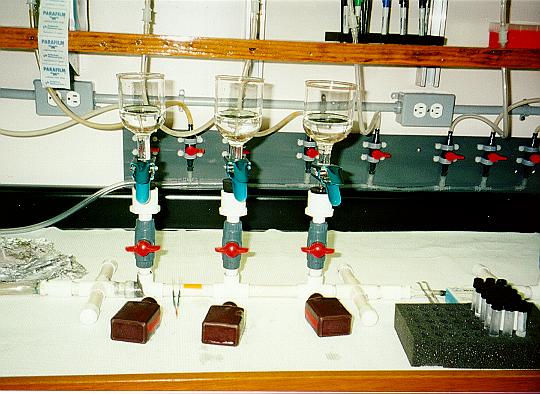|
Hawaii Ocean Time-series (HOT)
in the School of Ocean and Earth Science and Technology at the University of Hawai'i at Manoa |
|
| » Home » Analytical Results » TD-700 Chlorophyll | ||||||||||||||||||||||||||||||||||||||||||||||||||||||||||||||||||||||||||||||||||||||||||||||||||||||||||||||||||||||||||||||||||||||||||
Sampling ProcedureIn mid-2000 we started measuring chlorophyll a, b and c on a Turner Designs TD-700. Samples were filtered onto 25 mm GF/F glass fiber filters and put into 100% acetone similar to the standard fluorometric method. Samples were analyzed using the wavelength filters shown in Table 1 below. The average precisions during 2006 determined from triplicate analyses are presented in Table 2. Figure 50 shows the relationship between chlorophyll a measured using the TD-700 and chlorophyll a measured using the 10-AU as well as chlorophyll a, b and c measured by HPLC during 2006. Table 1: Wavelength filters used for TD-700 Chlorophyll analyses
Table 2: Precision of TD-700 Chlorophyll analyses during 2006
ResultsContour plots of TD-700 analyzed chlorophylls a, b and c from 0 to 200 dbars are shown in Figure 51. For every pigment, a maximum is observed at approximately 120 meters. Chlorophyll a concentrations by fluorometry show an annual cycle with winter maxima and summer minima. During HOT-116 (June 2000), chlorophyll a concentrations increased dramatically in the upper 45 m of the water. This feature appears associated with a large bloom of diatoms, as evidenced from the shap increases in chlorophyll c, particulate silica (Figure 69) and fucoxanthin (Figure 48). | ||||||||||||||||||||||||||||||||||||||||||||||||||||||||||||||||||||||||||||||||||||||||||||||||||||||||||||||||||||||||||||||||||||||||||


